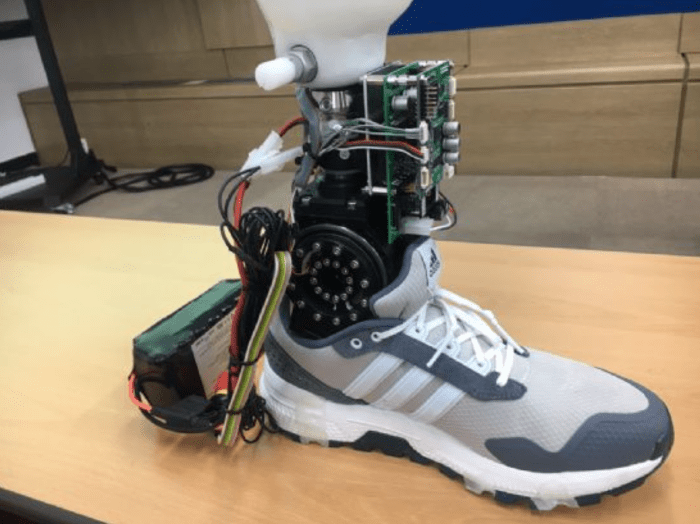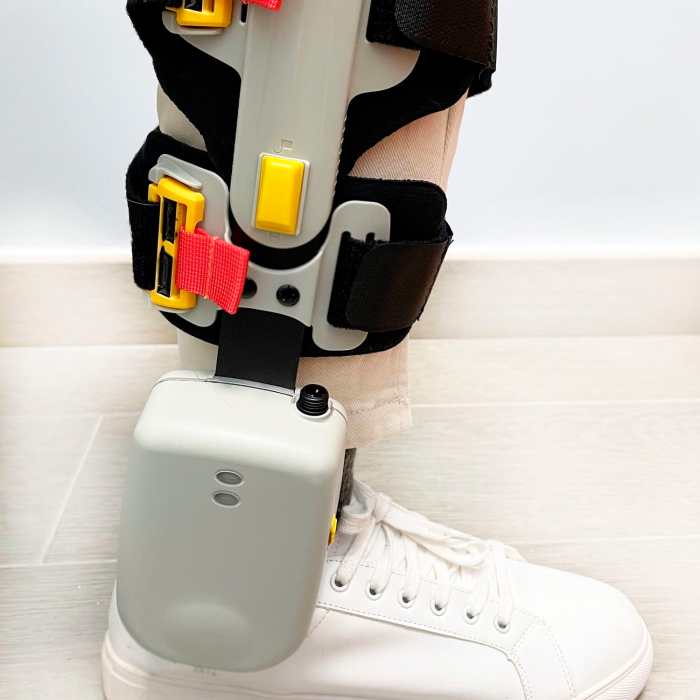Robotic Ankle Technology: Robotic Ankle Could Help Increase Mobility In Injured People
Robotic ankles are revolutionary devices designed to restore mobility and improve the quality of life for individuals with lower limb impairments. These devices utilize advanced technology to mimic the natural function of the ankle joint, providing support, stability, and enhanced movement capabilities.
Types of Robotic Ankle Devices
Robotic ankle devices come in various forms, each with unique features and applications tailored to specific needs.
- Powered Ankle-Foot Orthoses (AFOs): These devices are powered by electric motors and provide active assistance during walking. They are typically used for individuals with drop foot or weakness in the ankle muscles, enabling them to lift their foot during the swing phase of walking. Powered AFOs can adjust their support levels based on the user’s gait patterns and walking conditions.
- Passive Ankle-Foot Orthoses (AFOs): These devices provide passive support to the ankle joint, maintaining a desired position and preventing excessive movement. They are often used for individuals with spasticity or instability in the ankle joint. Passive AFOs can be made from various materials, including carbon fiber, plastic, or metal, depending on the user’s needs and preferences.
- Robotic Ankle Prostheses: These devices are designed for individuals with an amputation below the knee. They replace the missing ankle joint and provide a more natural and intuitive walking experience. Robotic ankle prostheses often incorporate sensors, actuators, and control systems to adapt to the user’s movements and terrain conditions.
Key Components of a Robotic Ankle
Robotic ankles are comprised of several essential components that work together to provide support, control, and feedback.
- Sensors: Sensors are crucial for collecting data about the user’s movements and environment. They measure variables such as ankle angle, joint position, ground reaction forces, and gait parameters. This information is then used by the control system to adjust the device’s support and assistance levels.
- Actuators: Actuators are responsible for generating the forces and movements required to support the ankle joint. They can be powered by electric motors, hydraulics, or pneumatic systems. Actuators provide the necessary power to lift the foot during the swing phase of walking, maintain stability during the stance phase, and adjust to different walking speeds and terrain conditions.
- Control Systems: Control systems are the brains of the robotic ankle. They receive data from sensors, process it, and send commands to the actuators. Control systems can be programmed to adapt to the user’s individual needs, gait patterns, and environmental conditions. They can also learn and adjust over time, improving the device’s performance and user experience.
Benefits of Robotic Ankles for Mobility Enhancement
Robotic ankles offer a transformative solution for individuals seeking to regain mobility after an injury or illness. These devices are engineered to mimic the natural movement of the ankle joint, providing a range of benefits that can significantly improve walking patterns and overall quality of life.
Improved Gait and Walking Patterns, Robotic ankle could help increase mobility in injured people
Robotic ankles are designed to assist with the complex movements required for walking, particularly during the swing phase when the foot lifts off the ground. By providing controlled ankle motion, these devices can:
- Enhance Foot Clearance: Robotic ankles can help individuals with foot drop, a condition where the foot drags during walking, to lift their foot higher, reducing the risk of tripping and falls.
- Improve Step Length: By assisting with ankle dorsiflexion (lifting the foot upwards), robotic ankles can help individuals take longer steps, leading to smoother and more efficient walking.
- Promote Natural Gait: Robotic ankles are programmed to mimic the natural biomechanics of the ankle joint, resulting in a more natural and less laborious walking pattern.
Enhanced Support and Stability
For individuals with ankle weakness or instability, robotic ankles can provide crucial support and stability, reducing the risk of further injury and improving confidence in walking.
- Reduce Ankle Strain: By assisting with weight-bearing and ankle movements, robotic ankles can reduce strain on the ankle joint, promoting healing and preventing further damage.
- Increase Balance and Stability: Robotic ankles can provide real-time feedback and adjustments to maintain balance and stability, especially during challenging terrain or uneven surfaces.
- Improve Proprioception: Some robotic ankles are equipped with sensors that provide feedback to the wearer about ankle position and movement, enhancing proprioception (awareness of body position) and improving balance.
Research Findings and Case Studies
Numerous studies and case reports have demonstrated the effectiveness of robotic ankles in restoring mobility and improving quality of life.
- Stroke Rehabilitation: A study published in the journal “Stroke” found that robotic ankle-foot orthoses (AFOs) improved walking speed and distance in individuals with stroke-related gait impairments.
- Cerebral Palsy: A case study reported in “Pediatric Physical Therapy” showed significant improvements in gait symmetry and walking efficiency in a child with cerebral palsy who used a robotic ankle device.
- Spinal Cord Injury: Research published in “The Journal of Spinal Cord Medicine” indicated that robotic ankle-foot orthoses could help individuals with spinal cord injuries regain functional walking ability and reduce reliance on assistive devices.
Applications of Robotic Ankles in Rehabilitation
Robotic ankles are revolutionizing rehabilitation by providing targeted, intensive therapy for individuals with mobility impairments. These devices are designed to assist and challenge patients, promoting functional recovery and improving their quality of life.
Rehabilitation Settings
Robotic ankles are employed in various settings to enhance mobility and promote recovery.
- Hospitals: Hospitals utilize robotic ankles in inpatient rehabilitation units, where patients receive intensive therapy after surgery or injuries.
- Clinics: Outpatient rehabilitation clinics incorporate robotic ankles into their therapy programs, providing ongoing support and progress monitoring.
- Home Settings: Advancements in technology allow some robotic ankle models to be used at home, enabling patients to continue their rehabilitation programs in a familiar and comfortable environment.
Role in Post-Surgical Recovery
Robotic ankles play a crucial role in post-surgical recovery, particularly after procedures affecting the ankle, foot, or lower leg.
- Improved Range of Motion: Robotic ankles provide controlled and repetitive ankle movements, helping patients regain flexibility and range of motion after surgery.
- Enhanced Muscle Strength: The resistance provided by robotic ankles strengthens muscles weakened by surgery, facilitating a faster return to normal function.
- Faster Recovery: By promoting early and intensive rehabilitation, robotic ankles contribute to a quicker recovery from surgery, allowing patients to regain independence sooner.
Role in Stroke Rehabilitation
Stroke rehabilitation often involves addressing mobility impairments, and robotic ankles are valuable tools in this process.
- Improved Gait: Robotic ankles assist patients in regaining proper walking patterns, improving coordination and balance after stroke.
- Enhanced Muscle Activation: The devices stimulate muscle activity, promoting neural re-education and re-establishing connections between the brain and the affected limbs.
- Increased Independence: By improving gait and strength, robotic ankles help stroke survivors regain mobility and independence, enabling them to participate in daily activities.
Benefits of Robotic Ankle Use in Rehabilitation
The following table summarizes the specific benefits of robotic ankle use in various rehabilitation scenarios:
| Rehabilitation Scenario | Benefits of Robotic Ankle Use |
|---|---|
| Post-Surgical Recovery | Improved range of motion, enhanced muscle strength, faster recovery, reduced pain and swelling |
| Stroke Rehabilitation | Improved gait, enhanced muscle activation, increased independence, improved balance and coordination |
| Spinal Cord Injury | Improved mobility, enhanced muscle strength, increased independence, reduced risk of falls |
| Cerebral Palsy | Improved gait, enhanced muscle activation, increased independence, reduced spasticity |
Future Directions and Research
The field of robotic ankle technology is rapidly evolving, with ongoing research and development focused on improving design, functionality, and integration with other assistive devices. These advancements hold immense potential for enhancing mobility and improving the quality of life for individuals with mobility impairments.
Advancements in Robotic Ankle Technology
Advancements in robotic ankle technology are driven by a desire to create more sophisticated, adaptable, and user-friendly devices. Research efforts are directed towards improving several key aspects of robotic ankles:
- Improved Design: Researchers are exploring new materials and design principles to create lighter, more durable, and comfortable robotic ankles. For instance, the use of advanced composite materials like carbon fiber can significantly reduce the weight of robotic ankles, making them more comfortable to wear for extended periods.
- Enhanced Functionality: Future robotic ankles are expected to incorporate more advanced functionalities, such as adaptive gait control, personalized movement patterns, and real-time feedback mechanisms. This will enable them to better adapt to individual user needs and preferences, enhancing the overall effectiveness of rehabilitation and mobility assistance.
- Integration with Other Assistive Devices: Research is also focused on seamlessly integrating robotic ankles with other assistive devices, such as powered wheelchairs, exoskeletons, and smart prosthetics. This integration will create a more comprehensive and synergistic approach to mobility assistance, enabling individuals to navigate their environment with greater ease and independence.
Personalized Rehabilitation Protocols
The development of personalized rehabilitation protocols is a crucial aspect of robotic ankle research. This involves tailoring rehabilitation programs to the specific needs and goals of each individual.
- Data-Driven Approaches: Researchers are using data from sensors and wearable devices to monitor patient progress and adjust rehabilitation protocols in real-time. This data-driven approach allows for more targeted and effective rehabilitation, maximizing the benefits of robotic ankle therapy.
- Artificial Intelligence Integration: Artificial intelligence (AI) is playing an increasingly important role in developing personalized rehabilitation protocols. AI algorithms can analyze patient data, identify patterns, and recommend customized exercises and treatment plans, ensuring that each individual receives the most appropriate and effective rehabilitation.
Ethical Considerations
The widespread adoption of robotic ankles raises important ethical considerations. It is crucial to ensure that these technologies are accessible, affordable, and used responsibly.
- Accessibility and Affordability: Efforts are underway to make robotic ankle technology more accessible and affordable for individuals with mobility impairments. This includes exploring alternative financing models, such as insurance coverage and government subsidies, to reduce the financial burden on patients.
- Potential Risks: It is essential to address potential risks associated with robotic ankle technology, such as safety concerns, potential for misuse, and ethical implications of enhancing human capabilities. Ongoing research and rigorous testing are crucial to mitigate these risks and ensure the responsible and ethical use of robotic ankles.
Robotic ankle could help increase mobility in injured people – The robotic ankle is more than just a technological marvel; it’s a symbol of hope and resilience. By empowering individuals to reclaim their mobility, it’s paving the way for a future where physical limitations are no longer barriers to living life to the fullest. As research continues to advance, we can expect even more innovative solutions to emerge, further revolutionizing the field of rehabilitation and helping countless individuals walk again.
Imagine a future where injured people can regain their mobility with the help of a robotic ankle. This incredible technology could revolutionize rehabilitation, giving individuals the freedom to walk again. And speaking of exciting advancements, Verizon will be offering the Galaxy S6 in gold after all , adding another stylish option for tech enthusiasts. Just like a new phone, a robotic ankle could be a game-changer, allowing people to rediscover the joy of movement.
 Standi Techno News
Standi Techno News

